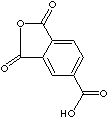|
TRIMELLITIC ANHYDRIDE |
|||
|
PRODUCT IDENTIFICATION |
|||
| CAS NO. | 552-30-7 |
|
|
| EINECS NO. | 209-008-0 | ||
| FORMULA | C9H4O5 | ||
| MOL WT. | 192.13 | ||
| H.S. CODE | 2917.39 | ||
|
TOXICITY |
Oral rat LD50: 2730 mg/kg | ||
| SYNONYMS | Trimellitic Acid Cyclic 1,2-anhydride; | ||
| Anhydro trimellitic acid; 1,2,4-benzenetricarboxylic acid cyclic 1,2-anhydride; 1,2,4-Benzenetricarboxylic anhydride; 4-carboxyphthalic anhydride; 1,3-dioxo-5-phthalancarboxylic acid; 5-phthalancarboxylic acid, 1,3-dioxo-TMAN; Trimellitic acid 1,2-anhydride; TMA; TMAN; Benzene-1,2,4-tricarboxylic-1,2-anhydride; Benzol-1,2,4-tricarbonsäure-1,2-anhydrid (German); 1,2-anhidrido del ácido benceno-1,2,4-tricarboxílico (Spanish); 1,2-Anhydride de l'acide benzene-1,2,4-tricarboxylique (French); | |||
|
SMILES |
|
||
|
CLASSIFICATION |
|
||
|
PHYSICAL AND CHEMICAL PROPERTIES |
|||
| PHYSICAL STATE | white to off white flakes with musty odor | ||
| MELTING POINT | 165 C | ||
| BOILING POINT | 390 C | ||
| SPECIFIC GRAVITY | 1.54 | ||
| SOLUBILITY IN WATER |
|
||
|
SOLVENT SOLUBILITY |
acetone 49.6 g/100g; cyclohexanone 38.4; 2-butane 36.5; ethyl acetate 21.6; dimethylformamide 15.5; xylenes 0.4; carbon tetrachloride 0.002; | ||
| pH |
2.0 |
||
| VAPOR DENSITY | 6.6 | ||
| VAPOR PRESSURE | 9.86E-06 (mm Hg) | ||
| log P | 1.95 (Octanol-Water) | ||
| OH RATE | 7.97E-13 (cm3/molecule-sec at 25 C) | ||
| HENRY'S LAW | 1.28E-10 (atm-m3/mole at 25 C) | ||
| NFPA RATINGS | |||
|
REFRACTIVE INDEX |
|||
| FLASH POINT |
227 C |
||
| STABILITY | Stable under ordinary conditions | ||
|
GENERAL DESCRIPTION & EXTERNAL LINKS |
|||
|
Trimellitic anhydride (1,3-dihydro-1,3-dioxo-5-isobenzofurancarboxylic acid in IUPAC systematic name) has similar structure to phthalic anhydride with the exception of the third functionality on the aromatic ring. It is a white flakes, readily hydrolysed to trimellitic acid. It is prepared by the heating crude trimellitic acid with vanadium pentoxide or by the liquid-phase air-oxidation of pseudocumene to form trimellitic acid, dehydrated subsequently. It is a reactive chemical compound offers many of its industrial uses. Trimellitic anhydride's main application is the esterfication of alcohols. Esters are produced in the ratio of three moles of alcohol to one mole of anhydride. Trimellitate esters are used as plasticizers for polyvinyl chloride, especially for high performance wire and cable insulation as these have principle features of temperature stability and low volatility. Trimellitate esters are less volatile and less water soluble than corresponding phthalates. These properties provide the application of high quality automotive interior linings, where the windscreen fogging is important. Trimellitic anhydride is used in the production of resins for electrode-position and powder coatings, and as a binder for glass fibres, and other aggregates. Trimellitic anhydride is used as an embossing agent for vinyl flooring and as a curing agent for epoxy resins. It is also used as an intermediate for the synthesis of surface coatings chemicals, adhesives, polymers, dyes printing inks, pharmaceuticals and agrochemicals.
...........Trimellitic-anhydride (the 1,2-anhydride of 1,2,4-tricarboxy benzene), hereafter referred to as TMA, contains both an aromatic acid group and a cyclic anhydride group. TMA should be interesting as an intermediate in the preparation of other compounds, such as polyesters and mixed esters, but its derivatives have not been investigated very thoroughly. Derivatives of TMA which have been prepared are described below. Since the three carboxyl groups are not symmetrical, it is easily seen that there are three possible monoesters, one ester anhydride, three diesters, and one triester for the case of esterification with a given monohydroxy alcohol. All of the possible methyl esters have been prepared by various methods. A thorough study of the methylation of trimellitic acid was conducted by Wegscheider, et al. The 1- and 2-methyl esters were prepared by boiling the acid with methanol, by heating the acid with methanol and a mineral acid, by partially hydrolyzing the trimethyl and the 1,2-dimethyl esters, and by treating methyl iodide with the appropriate silver salts. The 4-methyl ester was prepared by heating either the acid or the anhydride with methanol and by hydrolyzing the trimethyl ester............. (http://etd.gatech.edu/) |
|||
| SALES SPECIFICATION | |||
|
APPEARANCE |
white to off-white flakes | ||
|
ANHYDRIDE CONTENT |
97.0% min |
||
| MELTING POINT | 163-165 C | ||
|
COLOR , HAZEN |
150 max (molten state) |
||
| TRANSPORTATION | |||
| PACKING | 25kgs in Bag, 18mts in 20' container | ||
| HAZARD CLASS | |||
| UN NO. | |||
| OTHER INFORMATION | |||
| Hazard Symbols: XN, Risk Phrases: 37-41-42/43, Safety Phrases: 22-26-36/37/39 | |||
